The beauty of gardening in containers is that it can be done anywhere. Since you control the soil and water, plus you can decide what amount of sun to set the planter in, you know your plants will thrive. Sometimes, we just need to see ideas to inspire us on how to select coordinating colors or how to position the containers in an attractive grouping. Here are 14 container gardening ideas to get your creative wheels turning.
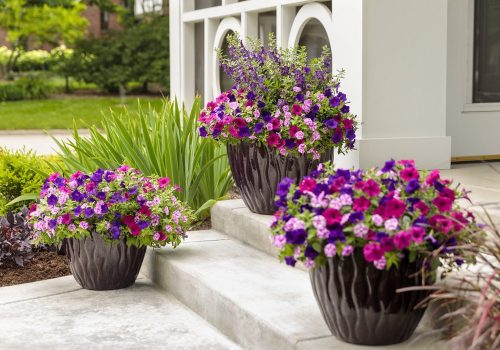
1 – Supertunia Petunias for Sunny Porches
Exposure: Full sun to light shade
Plants used: Mixed colors of Supertunia® petunias
Petunias are classic flowers for porch pots and they come in a rainbow of colors. Mix your favorites in one container to get the look you see here. When you use self-cleaning Supertunia petunias, you’ll have a bounty of blooms from spring through fall without the work of removing any of the spent flowers. See which Supertunia variety is right for you in this blog.
You’ll find that petunias bloom best in full sun, meaning more than six hours of sun per day, but light shade won’t hurt. Feed them once per week with water soluble plant food to provide them with plenty of nutrients to keep those blooms coming.
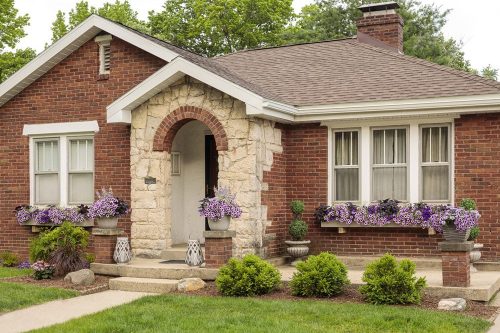
2 – Matching Porch Pots and Window Boxes
Exposure: Full sun to light shade
Plants used: Various purple Supertunia® petunias, Sweet Caroline purple sweet potato vines, purple Angelface® angelonia
Here, we’ve taken the idea from #1 and expanded it to coordinate the porch pots and window boxes for one cohesive look. By repeating light and dark purple tones in the porch pots and window boxes, we’ve tied everything together from one end of the house to the other. If purple isn’t your jam, try pink, red, or any other color that moves you.
One nice thing about repeating a grouping of flowers in one space is that they will all require similar care. You can water and feed them all at the same time and in the same amount, eliminating all the guesswork.
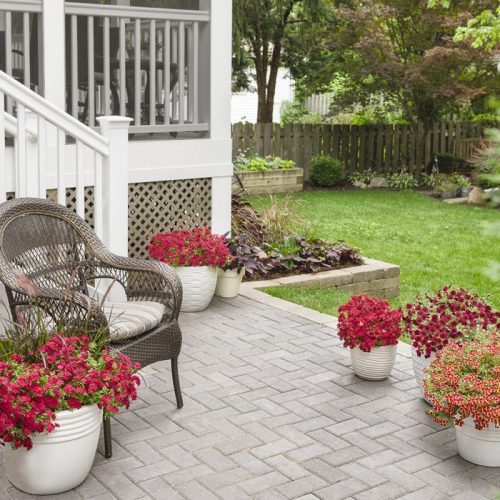
3 – Monochromatic Container Gardening Ideas
Exposure: Full sun
Plants used: Intensia® Red Hot phlox + various red-flowered Superbells® calibrachoa
Choosing a single color and then exploring plants within it is an easy way to simplify your container plantings. It also might challenge you to try new plants you haven’t yet grown that fit into the color scheme. Pick any color you like! We chose red to make this patio feel warm and welcoming. The idea of a monochromatic planting can be used to equally strong effect in sun or shade by choosing appropriate plants for your light conditions.
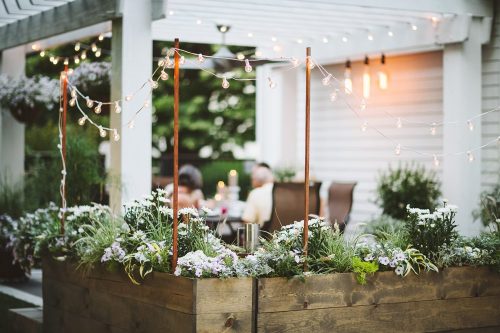
4 – Grow a Moon Garden in Containers
Exposure: Full sun
Plants used: Mixed annuals and perennials in shades of white and silver including Supertunia petunias, artemisia, Sky Rocket fountain grass and shasta daisies
If you find that you have the most free time to enjoy your garden in the evening, consider planting a moon garden. Soft evening light and moonlight are reflected in the white and silver plants, making them glow in the low light.
Any plants with white flowers or silver foliage will work, so don’t worry if you can’t find exactly what you see in this picture. Here, large rectangular planters filled with white and silver plants line the edges of a patio where this family often entertains in the evening. They create an elegant atmosphere without overpowering the space.
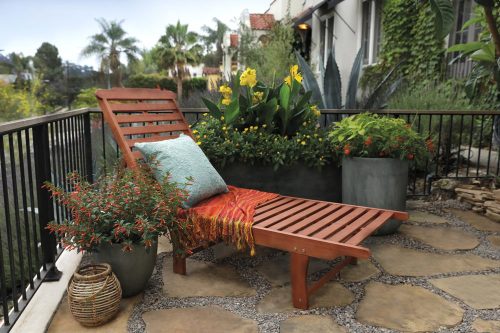
5 – Container Gardening in Hot, Sunny Spaces
Exposure: Full sun
Plants used: Toucan® canna lilies, Vermillionaire® cuphea, ColorBlaze® coleus, Luscious® lantana
Choose your plants and containers carefully if your space receives all-day sun, especially if you live in a warm climate. Thicker walled containers and self-watering AquaPots® are best since they help to keep the plants’ roots cooler and retain moisture longer. Try not to let the soil dry out, as it can be difficult to rehydrate if you garden in intense dry heat.
Plants that can tolerate some dryness and that are described as heat tolerant will all be good choices for these conditions. A few more you might try in addition to those you see here include: Evolvulus, Bidens, Helichrysum, Calylophus, Gaillardia and Vinca.
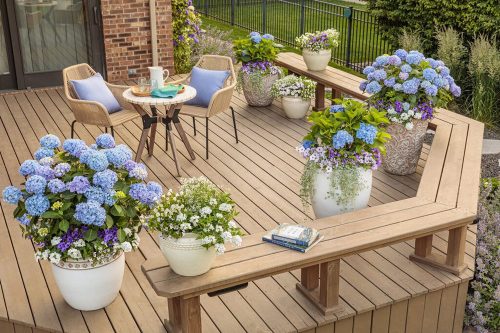
6 – Mixing Annuals and Shrubs in Containers
Exposure: Full sun to part shade
Plants used: Let’s Dance® Blue Jangles® bigleaf hydrangea, Diamond Snow® euphorbia, mixed purple and white varieties of Superbena® verbena and Supertunia Mini Vista® petunias
Containers aren’t just for growing annuals. Flowering shrubs like dwarf hydrangeas are also lovely in containers, and they can be paired with annuals to provide continuous color all season. This is especially useful in climates where the soil isn’t amenable to growing hydrangeas or if your soil is often quite dry. When you grow hydrangeas in containers, be sure to use a high quality potting soil and don’t let your plants dry out to the point of wilting. This blog explains all the ins and outs of growing hydrangeas in containers.
If hydrangeas need afternoon shade in your climate, swap the sun loving trailing annuals you see here for varieties that can handle some shade like Torenia, ivy, Tradescantia or Alternanthera.
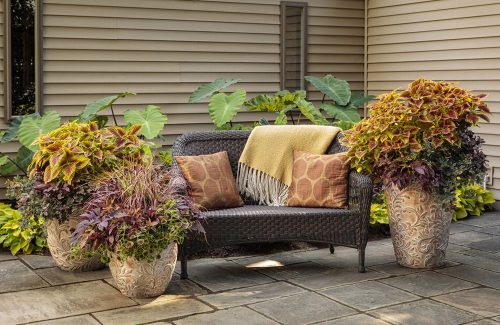
7 – Container Plants that Thrive in Both Sun and Shade
Exposure: Sun or shade
Plants used: ColorBlaze® coleus, sweet potato vine, Plum Dandy™ alternanthera, ‘Fireworks’ fountain grass
Most plants prefer either sun or shade, but there are a few like coleus, begonias, Diamond Frost® euphorbia, alternanthera and wishbone flower that will grow well in just about any amount of light. They are useful for planting in areas where it is shaded for much of the day but there are a few hours of intense afternoon sun. They also work well when you are trying to achieve a symmetrical planting but the light conditions are different—in containers on either side of your front porch, for example.
In this photo, varieties of ColorBlaze® coleus are featured prominently as upright thrillers and trailing spillers. They are paired with a lacy variety of sweet potato vine that can also handle some shade. ‘Fireworks’ fountain grass grows best in full sun, so if your container will be in the shade, swap it out for Toffee Twist or ‘Bowles Golden’ sedge.
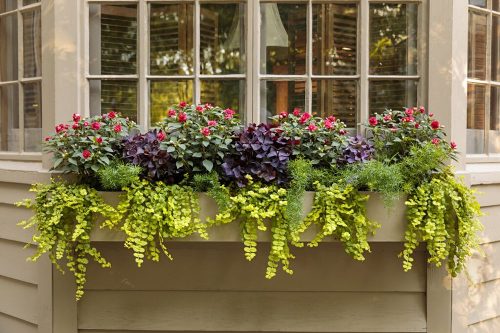
8 – Classic Shade Window Box
Exposure: Part shade to full shade
Plants used: Rockapulco® double impatiens, purple shamrocks, asparagus fern, Goldilocks creeping Jenny
Impatiens of all kinds are well-loved plants that have been used in shade containers and landscapes for decades. For window boxes where you’ll be viewing the flowers up close, we love to use double impatiens. Each flower looks like a perfect little rose and they bloom prolifically from spring to fall without deadheading.
Impatiens come in many different colors, so you can choose whichever one fits your color scheme. Here, Rockapulco Double Red impatiens play the starring role while several other plants grown for their colorful foliage plants round out the combination. Feed every one to two weeks with water soluble fertilizer for best flowering.
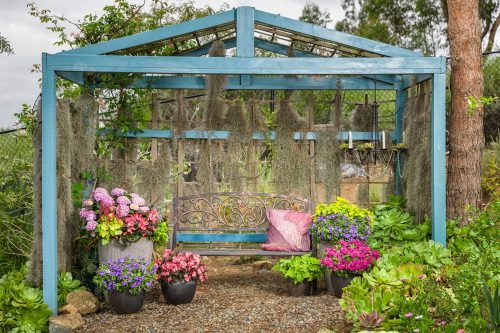
9 – Deck Out Your Hangout Space
Exposure: Part shade to filtered shade
Plants used: EndlessTM Illumination browallia, angelwing begonias, Rockapulco® double impatiens, ColorBlaze® coleus, chartreuse sweet potato vine, dwarf bigleaf hydrangea like Let’s Dance ¡Arriba!® or Wee Bit Giddy®
An instant way to add joy and a sense of exuberance to your outdoor spaces is to fill them with bright flowers that are guaranteed to make you smile every time you pass by. Under the filtered shade of this pergola, potted annuals and shrubs thrive in large, showy containers. You can’t go wrong by pairing pink, blue and chartreuse but this idea could also be adapted to suit any palette since all of the plants used come in multiple colors. Which would you choose for your own hangout space?
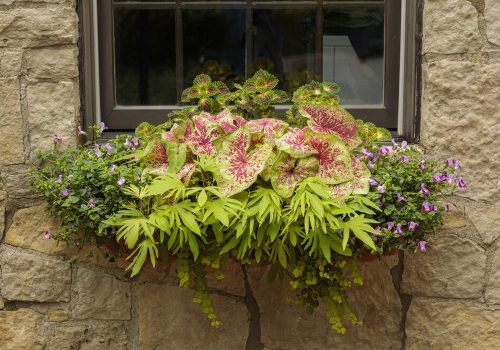
10 – Tropical Flair for Fancy Window Boxes
Exposure: Part shade to filtered shade
Plants used: Heart to Heart® caladiums, chartreuse sweet potato vine, trailing coleus, wishbone flower
Ready to try something with tropical flair in your window boxes this year? Choose Heart to Heart caladiums whose large, heart-shaped leaves in warm shades of pink, red and green bring that beachy vibe to window boxes and upright container recipes. We used shade loving ‘Raspberry Moon’ caladiums here, but by swapping them out for a more sun tolerant variety like ‘Scarlet Flame’ or ‘Heart and Soul’, you can grow this window box in full sun conditions.
The caladiums are underplanted with a unique palm-leaved sweet potato vine named Medusa™ Green, but you would prefer one with longer stems, choose a trailing variety like Sweet Caroline Sweetheart Lime instead.
Find more container gardening ideas for in the shade in this blog. All photos in this article are courtesy of Proven Winners.
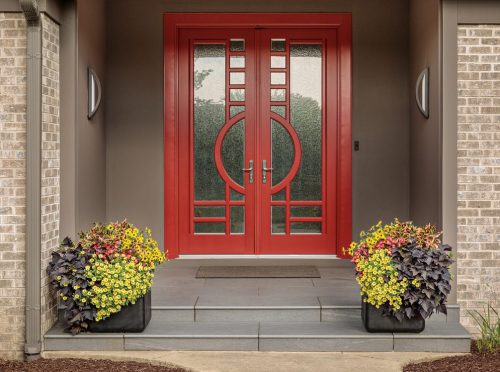
11 – Bold Entrance Plantings
Exposure: Full sun to part sun
Plants used: Suncredible® Yellow sunflower, ColorBlaze® El Brighto coleus, Surefire® Cherry Cordial™ begonia, Supertunia Mini Vista® Yellow petunia, Sweet Caroline Bewitched After Midnight™ sweet potato vine
Make a bold statement right from the start by planting up a pair of large flower pots to flank your front entrance. In this instance, the pots were pulled to the edge of the porch rather than set up against the door wall to take advantage of the brighter light up front. All five types of plants included are extremely vigorous, so they are able to compete with one another without fear of some getting overrun. By midseason, these plants will have grown nearly three feet tall and trailed over two feet long. You can always count on bright primary colors to make a bold pairing.
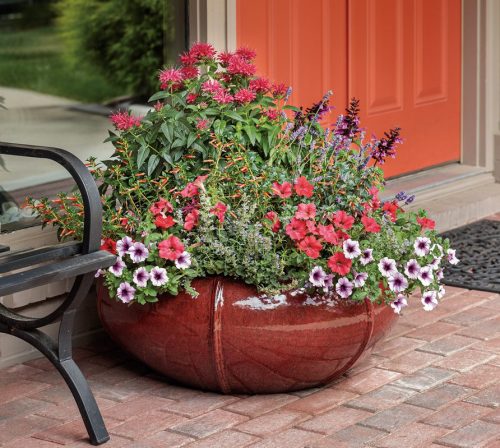
12 – Pollinator Garden in a Pot
Exposure: Full sun
Plants used: ‘Pardon My Cerise’ bee balm, Unplugged® Pink salvia, Vermillionaire® cuphea, Supertunia® Really Red and Bordeaux™ petunias, Sweet Romance® lavender, ‘Cat’s Pajamas’ catmint
No room to plant a whole pollinator garden in your landscape? Here’s a container gardening idea: find a large container (32” bowl pictured) and pack it full of flowers that are beloved by bees, butterflies and hummingbirds. This example includes a mix of annuals and perennials, but the same could be done using exclusively flowering annuals to accomplish the same goal. Just be sure to choose varieties that will provide non-stop blooms to keep the pollinators returning to feed all season long.
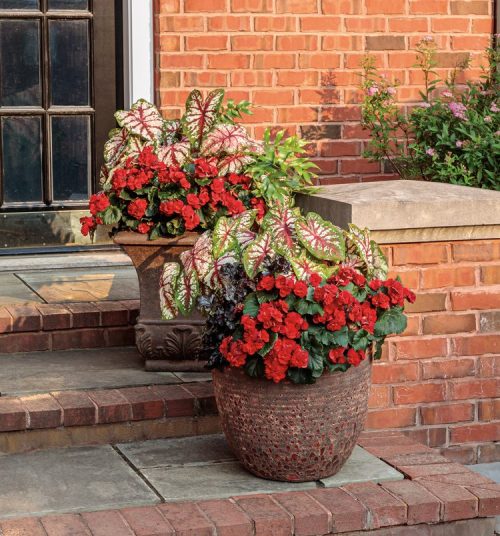
13 – Striking Foliage/Flower Pairing
Exposure: Part sun/part shade
Plants used: Heart to Heart® ‘Bottle Rocket’ caladium, Solenia® Scarlet Rieger begonia, Dressed Up® ‘Evening Gown’ coral bells
Combining plants with fantastic foliage and vibrant blooms in containers or landscapes delivers the best of both worlds. The possibilities are endless – challenge yourself to try something new every year using different color schemes and plant types. Take photos so you will remember which plants grew best to make shopping easier in the future.
In the pairing pictured here, the red veining in the ‘Bottle Rocket’ caladium foliage is complemented by the bold scarlet begonias which bloom all season, while dark purple coral bells add depth and drama. You’ll find that growing this recipe in part sun or part shade will result in the best coloration and happiest plants.
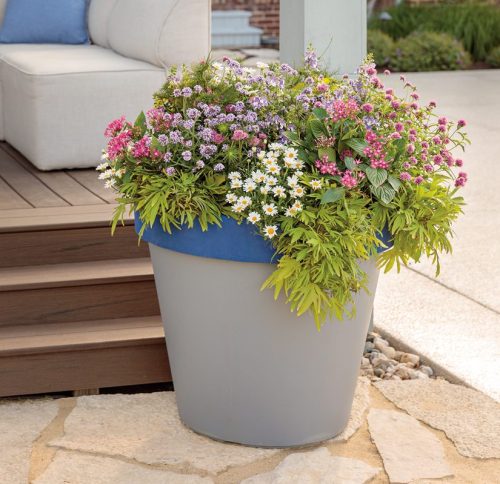
14 – Contained Cutting Garden
Exposure: Full sun
Plants used: Sunstar® Rose pentas, Meteor Shower® verbena, Angelface® Wedgwood Blue Angelonia, Truffula™ Pink gomphrena, Pure White Butterfly® Argyranthemum, Sweet Caroline Medusa™ Green sweet potato vine
Do you like to have fresh flowers readily available for cutting? You might already be growing plants in your landscape for this purpose, but filling a container near your back door or patio with plants for that purpose can make it easy to clip a few blooms for the kitchen table or your bedside table. You could even throw a few herbs into the mix.
In the example pictured here, one large 36” diameter pot is filled with annuals that bloom non-stop all season and make longer lasting cut flowers. Altogether, they’ll keep your vases filled from spring to fall. (Note that this picture was taken relatively early in the season. Most of the plants will reach about 2 ½’ tall with long stems that are perfect for cutting.)
All photos in this article are courtesy of Proven Winners.
